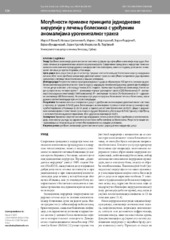Please use this identifier to cite or link to this item:
https://rfos.fon.bg.ac.rs/handle/123456789/835Full metadata record
| DC Field | Value | Language |
|---|---|---|
| dc.creator | Bizić, Marta R. | |
| dc.creator | Cvetinović, Nataša | |
| dc.creator | Majstorović, Marko J. | |
| dc.creator | Radojičić, Zoran | |
| dc.creator | Vukadinović, Vojkan | |
| dc.creator | Krstić, Zoran | |
| dc.creator | Đorđević, Miroslav L. | |
| dc.date.accessioned | 2023-05-12T10:25:22Z | - |
| dc.date.available | 2023-05-12T10:25:22Z | - |
| dc.date.issued | 2012 | |
| dc.identifier.issn | 0370-8179 | |
| dc.identifier.uri | https://rfos.fon.bg.ac.rs/handle/123456789/835 | - |
| dc.description.abstract | Introduction Urogenital congenital anomalies are among the most common congenital anomalies and very frequent pathology in paediatric urology. Health care systems strive to shorten the duration and reduce the costs of hospitalization, while maintaining treatment effectiveness. Objective To evaluate the duration of hospital stay of surgically treated patients with congenital urogenital anomalies and estimate the possibility of using fast track surgery principles in paediatric urology in the local settings of a developing country. Methods Retrospective non-randomized study included 552 patients who had been surgically treated at the Urology Department of the University Children's Hospital, during 2010. In line with their congenital anomalies, all patients were classified in one of four groups: I - upper urinary tract anomalies (252 patients); II - genital anomalies (164 patients); Ill - testicular anomalies (76 patients) and IV - associated anomalies (60 patients). We analyzed the total duration of stay as well as pre- and post-operative stay in the hospital. Results The average duration of hospitalization was 4.7+/-4.0 days. Patients with testicular anomalies stayed for the shortest period (2.3+/-1.9 days) (p LT 0.01) and patients with associated anomalies stayed in the hospital the longest (6.5+/-4.7 days) (p LT 0.01). Conclusion Modern methods of surgical treatment allow reduction of hospitalization, financial savings to the healthcare system and greater comfort for patients. Our results showed that this is also possible to apply in our environment. | en |
| dc.publisher | Srpsko lekarsko društvo, Beograd | |
| dc.rights | openAccess | |
| dc.rights.uri | https://creativecommons.org/licenses/by-nc/4.0/ | |
| dc.source | Srpski arhiv za celokupno lekarstvo | |
| dc.subject | urogenital tract | en |
| dc.subject | fast track surgery | en |
| dc.subject | congenital anomalies | en |
| dc.subject | children | en |
| dc.title | Possibilities of Fast Track Surgery Principles in the Treatment of Congenital Urological Anomalies | en |
| dc.type | article | |
| dc.rights.license | BY-NC | |
| dc.citation.epage | 331 | |
| dc.citation.issue | 5-6 | |
| dc.citation.other | 140(5-6): 326-331 | |
| dc.citation.rank | M23 | |
| dc.citation.spage | 326 | |
| dc.citation.volume | 140 | |
| dc.identifier.doi | 10.2298/SARH1206326B | |
| dc.identifier.fulltext | http://prototype2.rcub.bg.ac.rs/bitstream/id/1188/831.pdf | |
| dc.identifier.pmid | 22826986 | |
| dc.identifier.rcub | conv_1434 | |
| dc.identifier.scopus | 2-s2.0-84865163120 | |
| dc.identifier.wos | 000306381100009 | |
| dc.type.version | publishedVersion | |
| item.cerifentitytype | Publications | - |
| item.fulltext | With Fulltext | - |
| item.grantfulltext | open | - |
| item.openairetype | article | - |
| item.openairecristype | http://purl.org/coar/resource_type/c_18cf | - |
| Appears in Collections: | Radovi istraživača / Researchers’ publications | |
This item is licensed under a Creative Commons License


